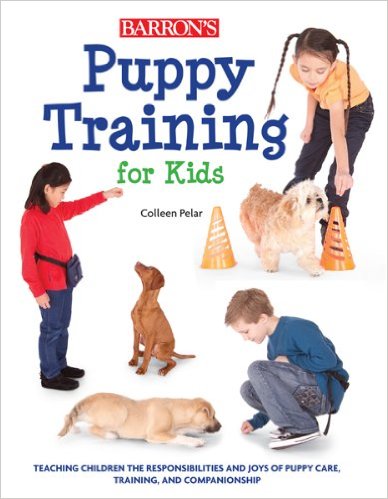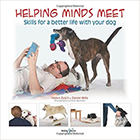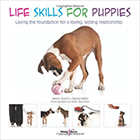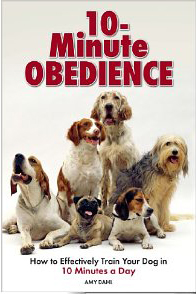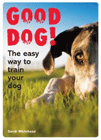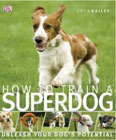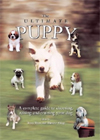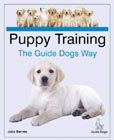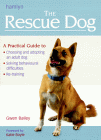Books on Animals: Dogs
Puppy and manners training
If you want to buy a book, clicking on the book cover will take you directly to that book on the Amazon.co.uk web site.
See also:

Puppy training for kids
Colleen Pelar’s short book is written for younger readers, and is especially useful for parents who plan on bringing a pup into their homes. It’s easy for children to understand, and can help them to see life from the pup’s point of view. ‘Puppy training for kids’ is pretty basic, so is less useful for parents who have had pups for a while, and who have already taught their children to be sensible and considerate around pups and dogs. It can, however, save you a lot of effort as part of the preparation for bringing a pup into your home.

Do as I Do: Using Social Learning to Train Dogs [With DVD] Paperback – 30 Jun 2014
‘Do as I Do’ is a groundbreaking little book, born of research into social learning at the ethology department of Budapest University, Hungary. In his introduction, Adam Miklosi, head of the department, writes that dog training ‘should be about the synchronization of the behavior of dog and owner’, rather than just focusing on the dog. This is what newer guides to raising dogs, like ‘Life Skills for Puppies’(1) and ‘Helping Minds Meet’ (2) aim to achieve, but ‘Do As I Do’ is truly innovative in focusing on a particular aspect of social learning, harnessing the desire of dogs to copy us, so that it becomes a talent, rather than a nuisance, as when dogs ‘help’ us with gardening.
Read more: Do as I Do: Using Social Learning to Train Dogs [With DVD] Paperback – 30 Jun 2014

Control Unleashed: The Puppy Program
Control Unleashed: The Puppy Program is geared to people raising pups, especially those with whom they want to do dog sports. It’s also extremely useful for people with adult dogs, rescue or otherwise, who need remedial work on little quirks that can make life difficult, especially getting distracted by exciting things happening, or getting spooked by weird things Out There. There‘s a lot of emphasis on getting dogs to pay attention to you and on teaching dogs how to cope. Though the book can be used for remedial work, as with Zulch and Mills’ ‘ Life Skills for Puppies’ (1), the focus is on preventing problems.

Helping Minds Meet - Skills for a better life with your dog
Helping Minds Meet follows on from the authors’ Life Skills for Puppies (1), and, like the previous book, looks at training in a wider context, at the dog’s ability to cope, rather than just obey commands. Helping Minds Meet also stresses ways to develop a good relationship with our dogs, starting out with recognizing that we have different priorities, partly because we come from different species. Differences can be a source of strength, as well as a source of disagreement, and part of forming a good relationship is learning to accept and use those differences.
Read more: Helping Minds Meet - Skills for a better life with your dog

Life Skills for Puppies: Laying the foundation for a loving, lasting relationship.
Helen Zulch and Daniel Mills are both vets and specialists in dog behaviour, with a strong belief that preventing behavioural problems is better than trying to cure them once they’ve become bad habits. ‘Life Skills for Puppies’ looks at the skills that pups need to learn in order to be able to cope with the world. Each chapter focuses on a different skill, such as being able to listen, to follow rules, and to cope with surprises. There are also reminders to humans that pups need help with making choices, and that dogs have the right to be dogs, and even to say ‘no’. The aim is to teach pups to be resilient, and be able to cope with life as adults. The approach is more how to ‘raise’ a pup the way you’d raise a child, than how to train in the traditional sense.
Many guides to raising pups focus on more mundane aspects of puppyhood, like housetraining, with maybe some obedience training thrown in. It’s refreshing to read a book that takes a more holistic approach to raising a dog, for example, teaching a dog to choose to exercise self-control, rather than simply teaching the dog to obey commands. Raising dogs also involves two-way communication, but humans aren’t always able to understand what dogs try to tell us, so the photos are particularly useful, because they help with interpreting a pup’s body language.
I actually bought this book to use with an adult dog, who had had very little contact with humans before he came to me. He needed to learn some lessons that he should have learnt as a pup, so it made sense tackle some of the gaps in his education by starting at a puppy’s level of understanding. ‘Life Skills’ proved very useful as a guide to remedial training with him. It might be worth the authors stressing in later editions that adolescents, and even adult dogs, are still capable of learning many life skills, even though these skills are best learnt as pups.
This is probably the most useful puppy book around for novices and, because the authors take an innovative, holistic approach, it’s also a very interesting guide for experienced owners, which can pinpoint gaps in training programmes. Very highly recommended.
Review by Alison Lever 2015

10-Minute Obedience: How to Effectively Train Your Dog in 10 Minutes a Day [Kindle Edition]
Amy Dahl is a well-respected, highly experienced retriever trainer, who writes clearly, and treats readers as intelligent adults. 10-Minute Obedience is easy to read and use as a guide to training, partly because it has a strong structure. There are four parts, on puppies, obedience, manners and tackling behaviour problems. This is a very practical ‘how to’ book. There are explanations as to why some solutions are offered rather than others, but there’s no overload of theory or ‘philosophy’. Dahl also looks at training from the dog’s point of view, which helps us understand how to communicate better with our dogs.
‘10-Minute Obedience’ takes a reward-based, ‘hands-on’ approach to obedience training. A ‘hands-on’ approach has both advantages and disadvantages. An advantage is that ‘hands on’ methods can be part of a wider programme to teach your dog to accept being handled. However, before you try ‘hands-on training’, you do need to be able to handle dogs in ways that relax them, which means being able to read canine body language, so that you can tell whether your dog is relaxed, or stressed. It takes time to develop these skills.
Teaching your dog to accept, and even enjoy being touched is important whether or not you use hands-on methods. It makes it easier to check your dog for ticks and other problems, and makes your dog safer for vets, groomers, and other people who need to touch your dog. Helen Zulch and Daniel Mills’ ‘Life Skills for Puppies’ (1) devotes a whole chapter to teaching a pup to enjoy touch. If you haven’t worked on this already with your dog, it’s essential to do so before using a ‘hands on’ training method. You can learn faster with the help of an experienced trainer who can give you feedback on what your body language is telling your dog, and point out messages that your dog is sending you that you may have missed.
There’s a lot of emphasis on using a longe line for the initial stages of formal training in 10-Minute Obedience’. A great advantage of longe-line training is that it makes you very aware of what you’re communicating to the dog, because you have to focus on what you’re saying and on your body language. It’s also useful because the dog is reminded that you exist, and has no opportunity to develop bad habits, like chasing rabbits rather than coming when called!
Obviously, if you want off-leash reliability, you need to practice recalls off-leash as well. Dahl recommends doing this right from the start with young pups in a safe space, before they start more formal training with a longe line. The longe line training provides a solid foundation on which to build more advanced off-leash work in a safe space, with off-leash work in the open as the ultimate goal.
One minor grumble, the recommended equipment is described very precisely, and I found it difficult to buy everything by mail order. However, it’s quite possible to improvise, for example using a long line rather than the recommended cotton webbing longe line.
I tried the methods in the book on two adolescent sheepdogs, and found that they didn’t always behave as expected. One dog, for example, tended to lie down rather than sit, and it was easier to get him into a sit with a kibble lure, rather than moulding him. The other sat beautifully right from the start, with just a hand signal. Obviously, training is much easier if you start with a pup, because adolescents have already developed habits that can be difficult to change. This book may also be more geared to retrievers than to sheepdogs, which tend to be more biddable than retrievers, but also tend to have their own little quirks. I still found the book very useful, adapting it to each dog, rather than religiously following the text.
Formal obedience training is extremely useful. A timely ‘sit’ can help dogs stay out of trouble, and a solid ‘stay’ can be a life-saver. There are other books which give a broader view of foundation training. Leslie McDevitt’s ‘Control Unleashed: The Puppy Program’ (2), for example, focuses on ‘paying attention’, including arousal regulation, an area dealt with in less depth in Dahl’s book. McDevitt focuses more on strengthening the relationship between dog and handler, as a basis for agility or obedience work. The strength of Dahl’s book is that it very clearly sets out a modern approach to hands-on obedience training, so the two books can complement one another nicely.
Review by Alison Lever 2015
Notes
1) Zulch, Helen and Daniel Mills, B. (2012) Life Skills for Puppies. Hubble and Hattie, Dorset
2) McDevitt, Leslie (2015) Control Unleashed: The Puppy Program. Clean Rub Publications, South Hadley MA

Good Dog: The easy way to train your dog
Good Dog tells us in Chapter One that training should be fun. We can plan classes, and use our brains to make training enjoyable for ourselves and our dogs, rather than trying 'bullish tactics'. Most owners would agree with this. The author, Sarah Whitehead also advises us to fit training into daily routines, like during the advert breaks for TV programmes. It's true that if you have a lot of commitments, time management is important, as most owners, and parents would agree.
Where Good Dog really comes to life is in Chapter 5, which takes owners beyond basic manners training, towards teaching skills, for example moving from games of fetch to formal retrieves, or teaching scent work. Chapter 6 deals with harnessing inbuilt desires to teach dogs acceptable activities like agility, so they’re less likely to get up to stuff we find unacceptable. As a book for pet dog owners, Good Dog has a lot to offer. Dedicated owners can pick out ideas for teaching a wide range of skills to their dogs, using this book as a guide. Teaching skills to our dogs is likely to improve our relationships with them, because the more we do interesting activities with them, the better we understand one other.
Good Dog, then, has its strengths, though the book is sometimes confusing, and might frustrate people with dogs from working stock, and readers with a serious interest in training and behaviour. Why is this?

My Dog Pulls What Do I do
This is a very useful book on a very important topic. Walking on a slack leash is an essential skill for a dog, and it makes it easier for owners to control the dog in the faceof distractions, like heavy lorries. This method works for most owners. It is not an instant cure, but you should see a quick improvement, and there is no need for special equipment. There is no guarantee that it will work for you, but it´s worth giving it a try.

Barking: The Sound of a Language (Dogwise Training Manual) [Paperback]
This book looks at barking from the point of view of the dog, so helps owners understand why dogs bark, a step towards controlling the barking. There is help in tackling the problem of an extremely talkative dog, but as Turid Rugaas points out, sometimes our dogs are trying to tell us something with their barks, and it is worth listening. Very highly recommended.

How to Train a Superdog
A very good first general dog book for people who want practical advice rather than lots of pretty pictures. The book does deal with training, as the title implies, but also provides help right from the moment when you decide you want a dog. There is help with choosing a breed, developing exercise schedules, teaching basic obedience, and more complex skills. The illustrations make it easy to follow the instructions. It is refreshing to read books which focus on what dogs can do, as well as how to prevent them doing things we'd rather they didn't do. Yes, it is true that manners training is the solid bedrock, but training can go much further than this, to the benefit of both dogs and owners. This is one of a newer crop of canine guides which draws on recent research to help owners develop dogs' potential. A highly recommended starter book for anyone taking on a dog. Top of page

The Ultimate Puppy
Terry Ryan has been an obedience instructor since 1968 and has held seminars and lectures all around the world while Theresa Shipp has 8 years experience training, having run her own dog school for the past 5 (at the time of publishing), specialising in puppies and gundogs. She is also a member of the Association of Pet Dog Trainers (APBT), which was founded by the late John Fisher and is one of few recognised dog trainers' organisation whereby members must abide by a strict code of conduct and have gained academic and practical qualifications. To learn more about the APDT click here.

Puppy Training the Guide Dogs Way
Guide Dogs for the Blind have been rearing and training puppies for the most demanding responsibilities that we ask of any dog, keeping careful records of each dog and its progress, over the course many years. In doing so, they have created a puppy training programme by which all their dogs are reared to ensure the highest success rates.
Beautifully illustrated with lots of puppy photos and interspersed with case studies to highlight specific points, this book takes you through every stage of puppyhood, from understanding the importance of choosing a puppy from health-screened and well-natured parents; puppy-proofing your home; socialisation with other animals and getting pups used to different environments; basic ‘good manners’ training; the dreaded adolescence, and sports and activities you can do with your dog.
Although the book lightly covers breed specific differences in behaviour and character, dogs chosen for guide dog work are naturally biddable, and the guide dog training programme has been designed around particularly biddable dogs. For breeds of more independent and wilful character, a little more depth into finding and building on your dogs motivation would help the reader whose puppy is just as happy to carry on sniffing around the room as take any notice of his owner.
The training methods in this book are all motivation and reward based and although the much over-used ‘dominance’ word crops up with regard to the adolescent dog, it is nice to read a modern training book that doesn’t suggest your puppy will want to rule the world. An added plus for this book is that all royalties from its sale are donated directly to Guide Dogs for the Blind.
Review by Diana Attwood.

The Perfect Puppy (Revised Edition)
This is a revised edition of Gwen Bailey's best-seller, which is deservedly popular because of its clarity. It is very easy to follow, which is important if you feel a little frazzled, with few functioning brain cells, on account of the exploits of your pup. If you have to choose just one pup book, this is probably the best of the bunch.
Sometimes, it's true, Gwen Bailey seems to forget that owners may have non-dog lives, and cannot devote 24 hours out of 24 to their pups, however much they adore them. She is perhaps a little over-optimistic on how often owners can reasonably be expected to take their pups out for a wee, for example. The general principles are important though, and in this case, obviously the more a pup goes outside when he is likely to need to perform, the quicker he will learn to perform outside. You can also pick out the tips, such as staying with your pup when you take him out to wee, and praising your pup when he has performed.
The most useful time to start using this book is, of course, when your dog is still a pup, but you can also use it as a source of ideas for remedial education, both for dogs you have had since puppyhood, and any dog you may take on as an adult. True,.sometimes the tone is a bit hectoring. You may feel that you are a complete failure because your dog is long past puppyhood and is still not perfectly obedient. Don't be put off, just persevere, keep a training diary, and look back on the progress you have made, rather than trying to measure yourself against perfection.
On balance, this book is highly recommended, both as a puppy book, and as a very useful book for anyone seeking to train a dog, with lots of good ideas.

The Rescue Dog
A very useful book for anyone who needs to re-educate an adult dog, not just people who have taken on a rescue dog. The book is well illustrated, the tips are easy to follow, and their rationale is well-explained. Anyone taking on an adult dog will find this book helpful. It's also useful for people who have raised their dogs from pups, and found them to be a bit of a handful as they grow up. If you feel you bought 'The Perfect Puppy' too late, try this book! The story of Beau, a dog with serious behavioural problems, is told at the end, to show what can be done to re-educate dogs. This success story is heartening, though novices should be wary of taking on such dogs. Generally, this book is highly recommended.

Living with a Rescue Dog
The Dog's Trust, founded in 1891 and formerly known as the National Canine Defence League, is one of the most well-established and respected rescue and welfare charities in the UK and re-homes in excess of 9000 dogs per year.
Recent television programmes have highlighted the plight of the 'rescue' dog and the sad lives that some of these dogs have suffered, though in actual fact the majority of dogs that end up in rescue shelters have not been physically abused, but are simply victims of impulsive purchasing without careful research, and their owners changes in circumstance.

Childproofing Your Dog
This is essential reading for anyone combining or intending to combine children and dogs. Children and dogs love being together, but they need some help with learning how to get along with each other. Dogs need to be able to get used to children, and children need to learn what dogs like and don't like. This book deals with both sides of the equation, with a helpful chapter on 'Dogproofing your child'. There is also a discussion of which dog breeds are suitable for families with children. Not everyone will agree with Kilcommons' recommendations, and it's worth comparing his views with the recommendations in 'Choosing a Dog for Dummies', reviewed in our dogs general selection of books.

How to Teach a New Dog Old Tricks
This is a very useful book for learning how to train dogs, from young pups to older dogs who need to learn a few more skills, or unlearn some tricks that their owners would prefer they didn't do! Ian Dunbar focuses on how the dog understands what we are trying to get across, and he uses reward-based methods. He writes clearly, and his work is accessible to older children, as well as adult owners. He has a 'way' with both people and dogs, which can get the best out of both.

Urban Dog: The Ultimate Street Smarts Training Manual
Cis Frankel lives in the US city of Chicago where many of her clients work long hours and live in high-rise apartments. For many in the UK, this might sound quite horrifying, but none the less many people and pets co-exist quite happily under such circumstances, and in this book, Cis Frankel sets out to explain how to make the best of living with an urban dog.
To begin with, I found this book extremely hard to get into. I found that for the first few chapters, every time I put the book down, I would have to start from the beginning again. I can’t for sure say why, maybe because this book is so very much geared to an American reader; or the lack of colour – it is quite a large book for a training book of its kind, though design-wise it is nicely laid out. Once I was past that point, it became much easier but it still took me quite a long time to read.
Read more: Urban Dog: The Ultimate Street Smarts Training Manual

Clicker Training for Dogs
Over the past 2 decades there has been a dramatic change in the way we train dogs. As people have become uncomfortable using the more traditional, harsher methods of training, many new trainers have made a name for themselves using kinder reward based methods, but no-one to date has made such an impact as Karen Pryor, the dolphin trainer from Sea World, who brought us clicker training.
Clicker training is basically a method of conveying the message to a dog that he has done something very well and that for his efforts, he has earned a reward. First you teach the dog that the clicker means reward, then you teach him to work for the clicker in order to gain his reward. Basically, it is the same principle that we work on – we go to work to earn money, and we spend the money on things that we want.
Latest book reviews
Latest news and research
- Impact of facial conformation on canine health: corneal ulceration
- Prevalence of disorders recorded in dogs attending primary-care veterinary practices in England
- Disease control through fertility control: secondary benefits of animal birth control in Indian street dogs.
- Quantifying sources of environmental contamination with Toxocara spp eggs.
- Clostridium difficile in faeces from healthy dogs and dogs with diarrhea
- Impact of canine overweight and obesity on health-related quality of life
- Effect of a diet enriched with green-lipped mussel on pain behavior and functioning in dogs with clinical osteoarthritis
- Short, unstructured session with a dog reduces anxiety levels in students, and improves their mood
- Research suggests canine companionship helps calm children undergoing cancer treatment
- Dingoes in the dock
Care and behaviour of dogs
- Acknowledgments and further reading
- Aggression
- Appetite Loss
- Attention Seeking
- Barking
- Basic training
- Behavioural problems
- Behavioural problems in dogs
- Being sensible with traffic
- Bitches In Season
- Biting
- Canine Social Cognition, part 1: Dogs are special
- Canine Social Cognition, part 2: Differences between dogs
- Chasing Cars, Bikes, Joggers, Cats etc.
- Choosing a dog
- Coming when called
- Designing and using a dog garden
- Destructiveness
- Do you want your pet dog to have puppies?
- Dogs and diet
- Dogs don’t bite humans
- Dogs: Bringing up your puppy
- Dogs: Helping dogs with sound phobias, and fear of fireworks
- Fighting
- Finding a good training class
- Greeting guests politely
- Jealousy
- Jumping Up
- Learning that some animals are prey, others are not
- Mounting
- Multi-dog households: Enjoying life with more than one dog
- Phobias
- Poo Eating
- Possessiveness
- Recall
- Respecting other dogs in the household
- Respecting passers-by, human and canine
- Separation Anxiety
- Stealing
- There are acceptable and unacceptable places to perform (housetraining)
- Toilet Training
- Travelling safely in cars
- Using Flexileads safely
- Vet Phobias
- Walking nicely on the lead
- Walking On The Lead
- Wolves, Dogs and Humans

